Free standard domestic shipping from Queensland across Australia. 30-day returns.
For delivery to the USA and Canada, click here
Free standard domestic shipping from Queensland across Australia. 30-day returns.
For delivery to the USA and Canada, click here
The Appliqué craft of Rajasthan
November 06, 2022 5 min read
"If we are to preserve culture we must continue to create it."
Johan Huizinga
In Rajasthan, India—where the average temperature is 38.7 degrees Celsius (101 degrees Fahrenheit) and where rainfall is scarce—skilled craftsmen breathe new life into their surroundings with their exquisite handicrafts. From domestic items to religious icons and symbols of skill, these crafts enliven the arid desert landscape and provide comfort, and a means of livelihood to the local residents.
One such spellbinding intricate craft is Appliqué.
Introduction
The word "appliqué" has originated from the Latin word "applicare" and French word "appliquer" which means to join or attach. Formerly used to patch the holes in worn-out fabrics, this technique has found its way as a creative art form and is now used in a wide range of home furnishing and clothing items.
What is Applique?
The "Applique craft "refers to decorative needlework in which pieces of fabric in different shapes and patterns are sewn or stuck onto a larger piece to form a picture or pattern. Appliqué is a common technique in some kinds of textiles, but it can be applied to many materials. The edges are folded inwards and stitched in place using running stitch or whip stitch to reveal the base fabric creating a beautiful pattern.
Applique can also be three-dimensional, as it uses folding techniques to extend from the background fabric. It differs from "Patchwork" as patchwork refers to sewing different pieces of fabrics together creating a larger fabric.
Where did Reverse Applique first originate?
The history of Reverse Applique can be traced back to ancient civilizations like Egyptians, Mayans, and Chinese, etc. Applique and Reverse Applique were used for home furnishings, clothing, and tents by nomadic tribes in all continents from Hmong women of Laos, Kuna Indians of Panama to Rabaris, Bheel, and Mahajan communities of India.
In India, these techniques were used to repair worn-out blankets and clothes but during the 12th to 19th-century people gradually started to make canopies, animal covers, ceremonial costumes, religious banners, dowry items, home furnishings, etc. During the Mughal era, applique work was used to decorate the royal court and the clothes of imperial courtiers. Muslin fabrics adorned with applique trellis patterns became renowned since this era.
Applique work is majorly practiced in various states like Rajasthan (Barmer, Jodhpur, Ranthambore, Jaisalmer), Gujarat (Kutch, Kathiawar), Bihar, Himachal Pradesh (Kangra, Chamba), Odisha (Puri, Pipli), and Uttar Pradesh. The craft seems to have been prevailing all over India with each region having its distinctive style with different fabrics, colours, stories, and motifs.
What are the required tools and processes to do applique?
The following basic supplies are required for applique work:
- Fabric: Cotton fabrics such as Cambric, Muslin, and Organdy are traditionally used.
- Needle: Thin needles are used to sew the fabrics together.
- Chisel and Hammer: To make incisions based on the designs.
- Thread: Mostly the same colour thread as the top fabric is used, sometimes contrasting colours are used with decorative stitches.
- Markers: A fabric marker or chalk is used to draw the design.
- Colour paste: A homemade concoction used to trace the design on fabric.
- Gum paste: To paste the fabrics together.
Steps :
The first step involves drawing designs on transparent butter paper sheets using a marker and then tiny holes are made on the drawn lines using a compass or any sharp object.

In the second step, fabric pieces are cut into the required dimensions. The paper sheet is put on a fabric piece and a colourful paste or white paste (in case of dark dyed fabrics) is applied to it which traces the design on the fabric. This process is repeated for each different design.
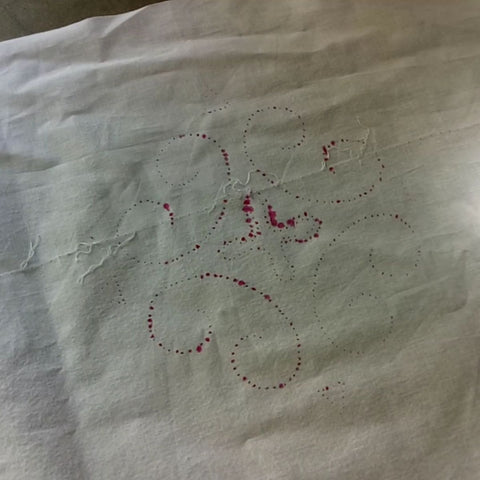
- The fabric pieces are layered carefully with the design traced fabric on top and the tiny incisions are made with a chisel and hammer throughout the layers. Following this, the pieces are pasted on the base fabric using a homemade gum paste.
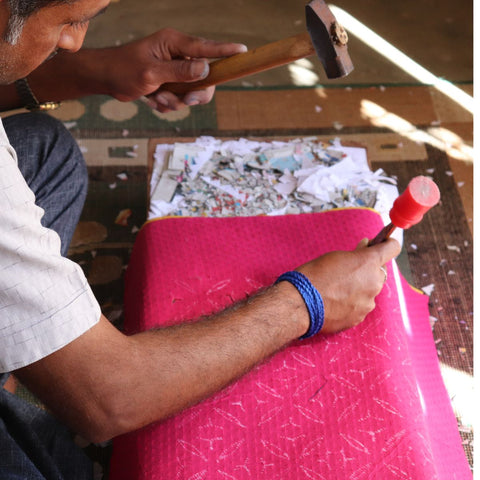
- After the glue dries, the cut edges of the top layer are folded inwards and sewn together by hand. This step requires undivided attention and incredible precision.

- These panels are then joined together to form the beautiful rhythmic surface of repetitive patterns.

- The fabric is soaked in water to remove the gum and dried in sunlight. Finally, extra yarns are cut, the fabric is properly ironed and inspected thoroughly to assure the best quality products.
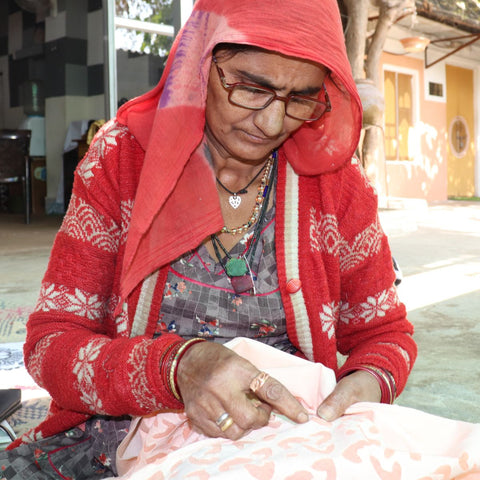
- Now the product is ready for final finishing which includes dry cleaning, washing, checking, ironing, packing etc.
What can be made from the applique fabric?
A technique born out of necessity has evolved into an interesting craft and today it is used for a wide range of products like applique cut work tablecloths, table runners, bed covers, cushion covers, curtains, clothing material, etc.
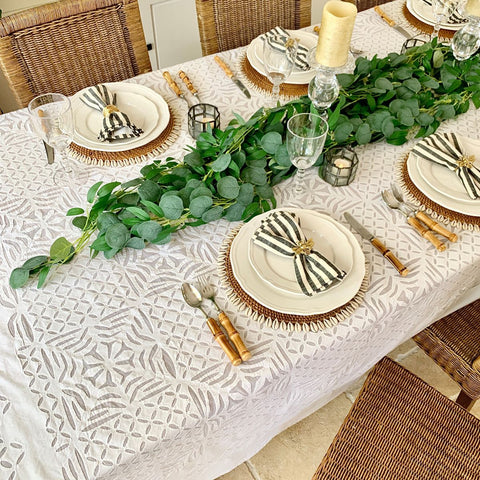
Applique cut work rectangle tablecloths
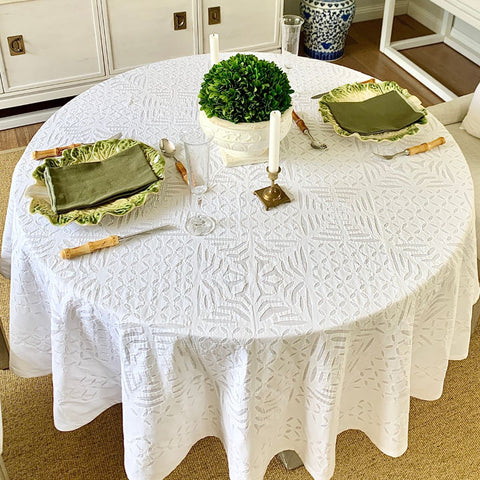
Applique cut work white round tablecloth
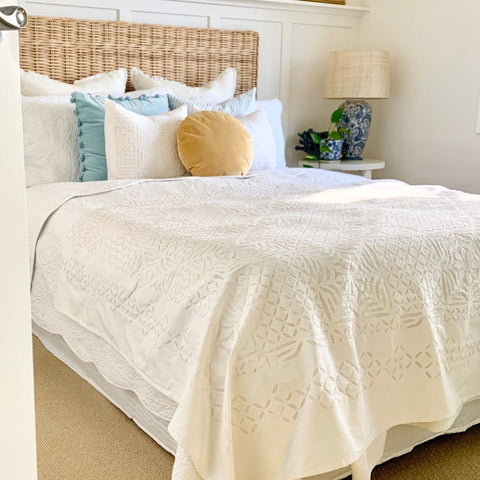
Applique cut work bedspread and cushion cover
What makes the applique craft so unique and special ?
Flaunting a myriad of cuts and motifs, applique work entirely differs from other textile techniques like printing and painting, as it has a three-dimensional effect on the fabric which is unique in itself. It takes over 20 days for one artisan to craft an item, from start to finish. The products represent the family bond, labour of love and devotion that its makers lavish on them. Men generally design the patterns and trace them on fabric pieces; while women skilfully sew the pieces together while keeping in mind the harmony between the scattered shapes.
The needles move rapidly over the fabric, following a rhythm that has become second nature. As each inch of the fabric goes through these dextrous fingers, it carries with it a memory of years of practice and love.
Conclusion:
Buying a handcrafted product can make a difference to the lives of many people. It helps preserve traditional skills, maintain cultural heritage and provide a means of sustainable livelihood for talented craftsmen.
Did you like reading about the applique, cut work craft? Do let us know your thoughts in the comments below :
Sources :-
https://mymodernmet.com/embroidery-applique/
https://www.orissapost.com/all-of-applique/
Leave a comment
Comments will be approved before showing up.

